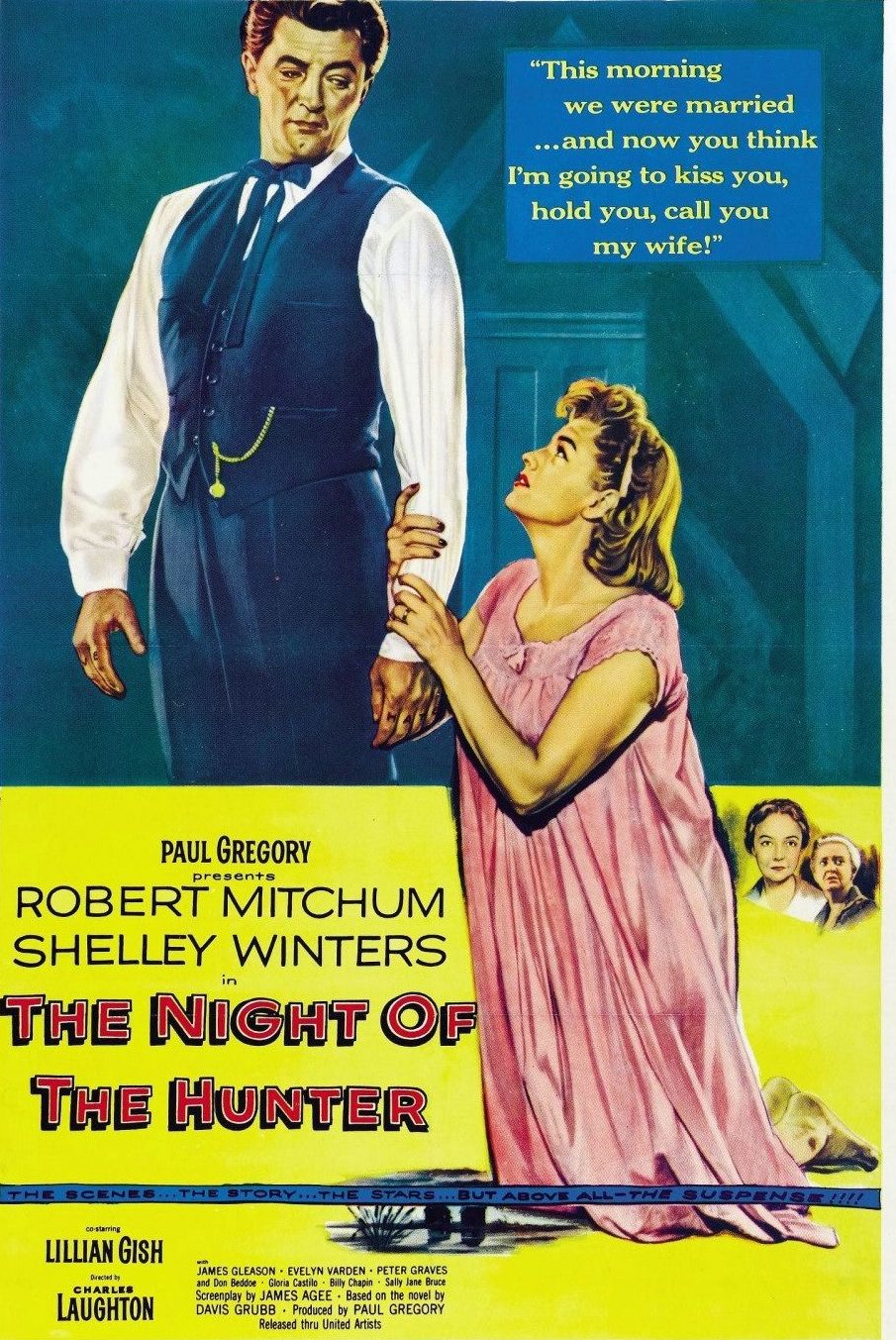‘The Night Of The Hunter’


“L-O-V-E” reads the tattooed right hand of Preacher Harry Powers (Robert Mitchum) — but don’t be lulled into complacency, for his left hand, compulsively grasping a switchblade as he watches a striptease dancer, bears the message “H-A-T-E.” One of cinema’s truly terrifying villains, Mitchum’s is a performance to savor — that is, if you’re into over-the-top sadism leavened by weaselly unction, a stark counterpoint to the virtuous goodness that finally does him in.
“The Night of the Hunter” is Charles Laughton’s 1955 expressionist masterpiece, but due to its commercial failure when released, tragically his only directed work. Laughton, a famed actor (“Mutiny on the Bounty,” “The Private Life of Henry VIII”), created a vivid vision that was named by Cahiers du Cinema in 2006 as the second-most admired film of all time, next to “Citizen Kane”). The taut, tight script, by famed film critic and essayist James Agee (in conjunction with Laughton), takes its momentum, and much of its terse dialogue, from its National Book Award-nominated source, the best-selling thriller by Davis Grubb (a talented but eccentric writer who once paid a taxi to bring him from Greenwich Village to a literary event in his West Virginia home town).
The film graphically illustrates the stark division between good and evil as Preacher (a self-anointed, but to say the least, theologically-confused clergyman) enacts for perplexed spectators a wrestling match between his two tattooed hands — which will win? And what will the result be for his soul? (As an admiring homage, the scene is reprised, in slightly different context, in Spike Lee’s 1989 film, “Do the Right Thing.”)
Preacher, announcing himself with turgid hymns, is, in fact, a serial killer who enters the film as the former cellmate of a recently-executed thief. He is on a mission to marry his companion’s widow (Shelley Winters) and extract the missing robbery funds from her two small children, sworn by their dead father to reveal nothing. He succeeds in the marriage, but soon leaves his new bride dead in her Model T convertible in the bottom of the river — a haunting but strangely beautiful image of flaxen hair and river bottom weeds flowing in the underwater current. But he is less successful in breaking the secret held by the two children, the gullible four-year-old, Pearl and the stoic 10-year-old, John. They flee on a skiff floating down the Ohio, followed by an increasingly unhinged black-hatted and black-suited fury.
As the children glide down the river, the film takes on a magical, elegiac tone. Laughton’s direction, and the film’s exquisite deep black and crisp white cinematography (by Stanley Cortez) and mesmerizing, often lyrical score (by Walter Schumann) exploit the story’s naturalistic setting as the brother and sister, watched over under starry nights and crescent moons by an Eden-like menagerie of loving animals, are swept along on a winding journey through Depression-era riverfront communities. It’s a deliberate Biblical parallel to the flight into Egypt, escaping King Herod’s murderous pursuit of innocent babies.
Finally, Pearl and John, fleeing evil, are rescued by the forces of good — Lillian Gish, the famous silent film actress, as Miss Cooper, a one-woman adoption agency who takes under her wing the lost children of the era’s “hard times.” Their rural household, a Dickensian rollicking family, keeps her wards safe, away from the sins of the outside world. Safe, that is, until Preacher tracks them down by seducing Ruby, an affection-starved teenager, into revealing the whereabouts of his “lost little lambs.” It then falls on Miss Cooper, brandishing a shotgun, to take on the role of defender as well as nurturer, setting up a tense standoff as her antagonist lays frightening siege to her home.
But Preacher is vanquished in a fast-moving climax, love overcoming hate — the right hand wins after all. In a sweeping, almost Faulknerian coda based on Grubb’s lyrical ending, the film closes with Gish’s moral presence — her elegy to the camera on the goodness and courage of the children — “They abide and they endure.”
Why is this film so satisfying today? Perhaps because in its binary metaphysics of good and evil, it presents a contrast to today’s ambiguous cultural divide (in which each side believes fervently in its own virtue, and in the worst of its counterpart). Or maybe it’s because it’s simply a gripping story well-told, beautifully filmed, and brilliantly directed. Would that we’d had more of Laughton’s vision.
“Streaming” is a periodic look at classic films, available on home networks and apps. “The Night of the Hunter” is available on streaming video on iTunes, Amazon Prime, Vudu, and Google Play.



